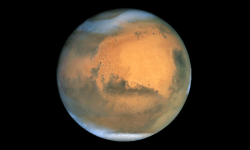
The star HR9024 loses weight due to incredible coronal mass ejections
– News of June 11, 2019 –
Observed from afar, the sun may seem like a shiny, smooth ball. Modern astronomy has shown that in reality the surface of our star is covered with bubbles and filaments, some of which may be absolutely gigantic. During the most violent solar flares, the sun can release highly magnetized plasma that mingles with solar winds. This phenomenon is called coronal mass ejections. These events can cause magnetic storms. When they hit Earth, we see magnificent polar auroras. We may think that the other stars of the universe have a similar behavior. For at least one of them, it’s now confirmed.
HR9024 is a variable star 455 light years from home. It is about three times more massive than the sun and ten times larger. Its rotation rate is high, which is why some researchers think that it has swallowed a giant planet in the past. This star has a very strong magnetic field, which generates incredible eruptions and coronal mass ejections. One of them was detected using the Chandra Space Observatory. This is not a direct observation.
Thanks to Chandra, the team of astronomers measured the speed of the plasmas surrounding the star. They found the typical signature of a coronal mass ejection. During this event, HR9024 would have ejected 10,000 times more material than during the most massive ejections observed on the sun. About a million billion tons were propelled at several hundred kilometers per second. We do not know if HR9024 has a planetary system. If so, there must have been a lot of damage.
This observation reinforces our understanding of the phenomenon of coronal mass ejection. It shows that what is observed in the sun can be applied on a larger scale, with some nuances. The plasma ejection rate of HR9024 is lower than previously thought. This may be a sign that big stars have more difficulty accelerating their plasma than small stars.
Coronal mass ejections of this magnitude also indicate how they can contribute to the loss of mass of their star. If at each of these events HR9024 ejects millions of billions of tons in the interplanetary space, it should have lost much weight during its existence. These ejections could also contribute in the long term to the slowdown of its rotation rhythm.
Being able to observe what is happening around other stars can help us better understand the sun. If we were able to predict what a coronal mass ejection would look like on HR9024, this means that our models describing the magnetic mechanisms that generate these events are correct. We may be able to refine them by detecting other ejections around other types of stars. In the meantime, we can be happy to orbit a relatively quiet star. Between the violent eruptions of the red dwarfs and the immense ejections of variable stars, our system seems very calm.

A star will be only 0.2 light-years far from us in 1.3 million years
– News of June 9, 2019 –
Currently, Proxima Centauri is the closest star to the sun, just 4.24 light-years away. The other two stars of the Alpha Centauri system are a little farther away, at 4.37 light-years. This triple system and the sun are getting closer. In about thirty thousand years, Alpha Centauri will be closest to us, a little more than three light-years away. Other stars could, however, come closer to us in the next few million years.
Thanks to the data from the Gaia astrometry mission, we have identified 26. The one that should make the transition closest to us is called Gliese 710. It is an orange dwarf which so far evolves to 63 light years from us. In 1.3 million years, it should pass so close that it will cross the Oort cloud of the sun only 0.2 light years away. Six other stars also have a high probability of passing less than 1.6 light-years over the next 15 million years.
Gaia helps us understand that the passing of stars in the vicinity of the sun seems quite common. The team that identified the 26 candidates for future passages think that there will be in reality six or seven times more because Gaia does not allow to determine their number. This information can help us understand how comets are regularly ejected into the solar system or why certain transneptunian objects have such eccentric orbits.
We can also imagine that Gliese 710 will be an exploration target, but humanity and a scientific community will have to exist in more than a million years. For our contemporaries and future generations, we will have to be satisfied with the 4 light-years that separate us from Proxima Centauri.
How does a star form ?
– News of September 15, 2019 –
The accretion time of a star before ignition depends on the type of star that is forming. For a star similar to the sun, it is a process that lasts about ten million years. Everything starts with a gravitational collapse within a nebula. This gravitational collapse can be done in just 1000 years to form a body in hydrostatic equilibrium. This body then has a temperature insufficient for fusion. It will begin a phase of accretion of the surrounding matter.
In a few hundred thousand years, the proto-star accumulates most of its final mass. This causes a gravitational contraction and a gradual rise in temperatures in the star’s core. When the temperature reaches 1 million degrees, the fusion reactions of the deuterium occur. This first phase of melting still raises the temperature in the core of the star. It takes about 10 million more years for the star to reach 10 million degrees. The proto-star can then begin to fuse with hydrogen, marking the beginning of its life as a true star.
Very massive stars can dramatically speed up this process. We estimate that some stars can reach the stage of hydrogen fusion in only 100,000 years.
Image by NASA, ESA and G. Bacon (STScI)









